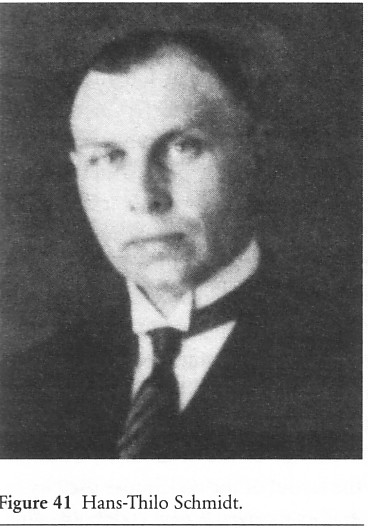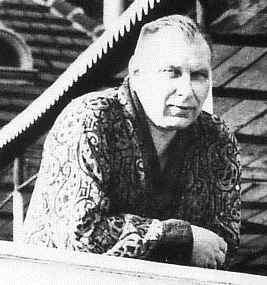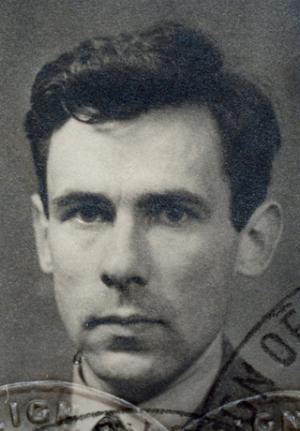<Back to Index>
- Spy Hans - Thilo Schmidt, 1888
- Science Historian and Codebreaker John W. Herivel, 1918
PAGE SPONSOR


Hans - Thilo Schmidt (13 May 1888 – 19 September 1943) code - named Asché or Source D, was a spy who, during the 1930s, sold secrets about the Germans' Enigma machine to the French. The materials he provided facilitated Polish mathematician Marian Rejewski's reconstruction of the wiring in the Enigma's rotors and reflector; thereafter the Poles were able to read a large proportion of Enigma enciphered traffic.
In the early 1930s, Schmidt was an employee at the German Armed Forces' cryptographic headquarters, the Cipher Office. Shortly after the military version of the Enigma machine was introduced, he contacted French intelligence and offered to supply information about the new machine. His offer was accepted by Captain Gustave Bertrand of French Intelligence, and he received from the French the code name Asché, and was assigned a contact, the French agent code - named Rex.
For the next several years, until he left his position in Germany, he met with French agents at various European cities and supplied them copies of the Enigma machine's instruction manual, operating procedures, and lists of key settings. Even with this information, however, French Intelligence was unable to break messages encrypted on the Enigma. Nor were the British cryptologists whom Bertrand contacted able to make any headway.
In December 1932, Bertrand shared intelligence obtained from Asché with the Polish General Staff's Cipher Bureau (Biuro Szyfrów). Mathematician - cryptologist Marian Rejewski had already set up a system of equations describing the operation of the then new German Army Enigma rotor wirings. The key - settings lists provided by Schmidt helped fill in enough of the unknowns in Rejewski's formulas, allowing him to speedily solve the equations and recover the wirings. That accomplished, the Poles were henceforth able to read Enigma traffic for nearly seven years to the outbreak of World War II as well as for a time into the War, while operating in conjunction with French intelligence in France. In a two week January 1938 trial, they solved and read about 3/4 of all German Wehrmacht — Army — Enigma intercepts: a remarkable result, considering that parts of the raw intercepts were garbled or incomplete due to interference.
After the battle of France, the French agent who had been Schmidt's case officer, a German citizen named Stallmann who went by the name "Rodolphe Lemoine" and used the code name "Rex," was arrested by the German Gestapo and betrayed Schmidt as a French spy. Schmidt was arrested on April 1, 1943, and in September 1943 his daughter was called on to identify his body; her account suggests that Schmidt may have committed suicide.

John W. Herivel (29 August 1918 – 18 January 2011) was a British science historian and former World War II code breaker at Bletchley Park.
As a code breaker concerned with Cryptanalysis of the Enigma, Herivel is remembered chiefly for the discovery of what was soon dubbed the Herivel tip or Herivelismus. The "tip" was an insight into the habits of German operators of the Enigma cipher machine that allowed Bletchley Park to easily deduce part of the daily key. For a brief but critical few months from May 1940, the Herivel tip in conjunction with "cillies" (another class of operator error) was the main technique used to solve Enigma.
Herivel wrote books and articles on Isaac Newton, Joseph Fourier, Christiaan Huygens, and an autobiographical account of his work at Bletchley Park, Herivelismus.
John Herivel was born in Belfast, and attended Methodist College Belfast from 1924 to 1936. In 1937 he was awarded a Kitchener Scholarship to study mathematics at Sidney Sussex College, Cambridge. Shortly thereafter, Herivel was recruited to Bletchley Park by his former supervisor Gordon Welchman, head of the newly formed Hut 6 section created to solve Army and Air Force Enigma. Herivel, then aged 21, arrived at Bletchley on 29 January 1940, and was briefed on Enigma by Alan Turing and Tony Kendrick.
At the time, Hut 6 were having only limited success with the Luftwaffe Enigma network known as "Red". Herivel was working alongside David Rees, another Cambridge mathematician recruited by Welchman, in nearby Elmers School, testing candidate solutions and working out plugboard settings. The process was slow, however, and Herivel was determined to find a method to improve their attack, and would spend his evenings trying to think up ways to do so. One evening in the middle of February 1940 he was considering the procedures followed by a German operator when using Enigma, and identified a potential mistake that could greatly aid the code breakers.
At the start of each day, the operator would set the "ring settings" (German: Ringstellung) on the Enigma rotors; that is, the position of the ring of letters (or numbers) around the rotor. The ring settings were taken from a code book, but changed daily, and had to be altered at the start of each day before any messages could be sent. The ring settings could be adjusted before or after inserting the rotors into the machine. Herivel assumed that at least some of the operators would adjust them after. In the normal course of things, adjusting the rotors inside the machine would likely leave the correct ring setting at the top, or near the top, of the rotors.
Furthermore, for each message, the sending operator would follow a standard procedure. He would first select a starting position for the rotors, the ground setting (German: Grundstellung): GKX, for example. He would then use Enigma with the rotors set to GKX to encrypt a second starting position, the message setting, which he might choose to be RTQ; RTQ might encrypt to LLP. (Before May 1940 the message setting would be repeated then encrypted, but this makes no difference to Herivel's observation.) The operator would then turn his rotors to RTQ and encrypt the actual message. Included in the preamble to the message, unencrypted, would be the ground setting (GKX) as well as the encrypted message setting (LLP). A receiving Enigma operator could use this information to recover the message setting and then decrypt the message.
The ground setting (GKX in the above example) should have been chosen at random, but Herivel reasoned that if an operator were lazy, or in a hurry, or otherwise under pressure, he might simply use whatever rotor setting was currently showing on the machine. If this was the first message of the day, and the operator had set the ring settings with the rotors already inside the machine, then the rotor position currently showing on the machine could well be the ring setting itself, or else very close to it. (If this situation occurred in the above example, then GKX would be the ring setting, or very close to it). Moreover, the ground setting was sent unencrypted in the preamble to the message, which could then be easily spotted by the code breakers at Bletchley Park.
The next day, Herivel's colleagues agreed that his idea was a possible way into Enigma. Hut 6 began looking for the effect predicted by the Herivel tip, and arranged to have the first messages of the day from each transmitting station to be sent to them early. They plotted the indicators in a grid termed a "Herivel square", an example of which is shown below. The rows and columns of the grid are labelled with the alphabet. Each ground setting received would be entered into the grid by finding the column corresponding to the first letter, the row corresponding to the second letter, and entering the third letter into the cell where the row and column intersected. For example, GKX would be recorded by entering a X in the cell in column G and row K.
A B C D E F G H I J K L M N O P Q R S T U V W X Y Z ---------------------------------------------------------- Z| |Z Y| S |Y X| |X W| L |W V| |V U| E |U T| |T S| |S R| K |R Q| S |Q P| |P O| |O N| N |N M| X |M L| W T |L K| X Y |K J| W X |J I| |I H| Q |H G| |G F| |F E| A |E D| |D C| V |C B| J |B A| P |A ---------------------------------------------------------- A B C D E F G H I J K L M N O P Q R S T U V W X Y Z
The Herivel tip suggested that there would be a cluster of entries close together, such as the cluster around GKX in the above example. This would narrow the options for the ring settings down from 17,576 (263) to a small set of possibilities, perhaps 6 – 30, which could be tested individually.
The effect predicted by Herivel was not immediately apparent in the Enigma traffic, however, and Bletchley Park relied chiefly on a different technique to get into Enigma: the method of "perforated sheets", which had been passed on by Polish cryptologists. The situation changed on 1 May 1940, when the Germans changed their indicating procedure, rendering the perforated sheets obsolete. Hut 6 was suddenly unable to decrypt Enigma.
Fortunately for the code breakers, the pattern predicted by the Herivel tip began to manifest itself. David Rees spotted a cluster in the indicators, and on 22 May an Air Force message sent on 20 May was decoded, the first since the change in procedure. The Herivel tip was used in combination with another class of operator mistake, known as "cillies", in order to solve the settings and decipher the messages. This method was used for several months until specialized code breaking machines designed by Alan Turing, the so-called "bombes", were ready for use.
Gordon Welchman speculates that the Herivel tip was a vital part of breaking Enigma at Bletchley Park, writing, "If Herivel had not been recruited in January 1940, who would have thought of the Herivel tip, without which we whould have been defeated in May 1940 — unable to maintain continuity until the bombes began to arrive many months later? Let there be no misconceptions about this last point. Loss of continuity would, at all stages, have been very serious, if not disastrous."
Because of the importance of his contribution, Herivel was singled out and introduced to Winston Churchill during a visit to Bletchley Park. He also taught Enigma cryptanalysis to a party of Americans assigned to Hut 6 in an intensive two week course. Herivel later worked in administration in the "Newmanry", the section responsible for solving German teleprinter ciphers using machine methods such as the Colossus computers, as assistant to the head of the section, mathematician Max Newman.
In 2005, researchers studying a set of Enigma encrypted messages from World War II noted the occurrence of the Herivel tip in messages from August 1941.
After the end of the war, Herivel taught mathematics in a school for a year, but he found he could not handle the "rumbustious boys". He then lectured at Queen's University Belfast, where he was a reader in the History and Philosophy of Science.He published books and articles on Isaac Newton, Joseph Fourier and Christiaan Huygens. In 1978 he retired to Oxford, where he became a Fellow of All Souls College. His books include:
- Herivel, John (1965), The Background to Newton's Principia: A Study of Newton's Dynamical Researches in the Years 1664 - 84 Based on Original Manuscripts from the Portsmouth Collection in the Library of the University of Cambridge, Clarendon Press;
- Herivel, John (1975), Joseph Fourier: the man and the physicist, Clarendon Press;
- Herivel, John (2008), Herivelismus and the German Military Enigma, M & M Baldwin.